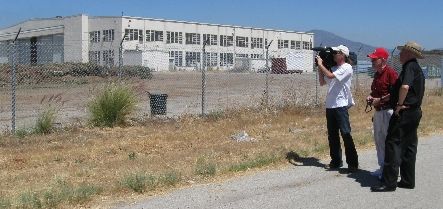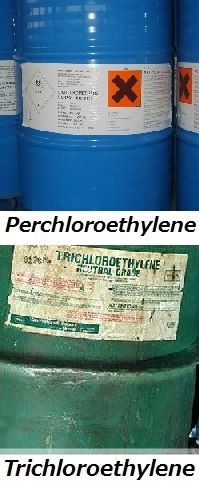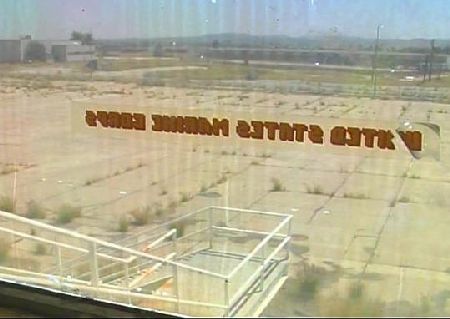
Publisher:
Bonnie King
CONTACT:
Newsroom@Salem-news.com
Advertising:
Adsales@Salem-news.com

~Truth~
~Justice~
~Peace~
TJP
Dec-14-2009 17:24

 TweetFollow @OregonNews
TweetFollow @OregonNews
Lejeune and El Toro: 'A Tale of Two Bases'
Robert O'Dowd Salem-News.comBoth Marine bases are EPA Superfunds sites. The govt. spent millions in remediation without disclosing the contaminants and health effects; there is no medical monitoring or health care for those injured, and hundreds of federal tort claims for Lejeune without going anywhere.
 Logos of the two Marine Corps bases Additional photos courtesy: madeinchina.com and firefighterswithparkinsons.org |
(SOMERDALE, NJ) - It’s no secret that Marines are a band of brothers. It doesn’t matter if you were in the Corps yesterday or 40 years ago. Once a Marine; always a Marine.
This news story is about Marine veterans and their dependents that were exposed to toxic chemicals at former Marine Corps Air Station El Toro, California, and Marine Corps Base Camp Lejeune, North Carolina.
These are men and women who served their country honorably, were unknowingly exposed to toxic chemicals and years later developed cancer and other serious diseases.
A skeptic might say: “Sorry to hear about your cancer, but many people get cancer that were not at these bases so what makes you think the disease was caused by something in the military?”
In fact, that is the very attitude our government has taken to deny any service connection to disease and contaminated water at Camp Lejeune and El Toro. Individuals have won VA disability and compensation claims but only after lengthy delays and payment of expensive independent medical evaluations in support of claims. Civil law cases were filed; but no win for the plaintiffs.
Both bases are EPA Superfunds. Millions were spent by the Navy in remediation at El Toro, sold at a public auction over 10 years ago to a real estate joint venture. The Navy made $650 million from the sale.
 MCAS El Toro, a ghost town Photo: Tim King Salem-News.com |
The evidence of contaminated drinking water at El Toro is muddled at best. Like Lejeune and many other military bases, El Toro’s drinking water originally came from base wells. The water under the base was free. For some unknown reason, the Navy purchased municipal water and the dates the base wells were abandoned are unknown. What is known is that a major trichloroethylene (TCE) plume cut a path through the base wells several miles into Orange county, extensive corrosion was found in the wells before they were sealed and all of the water supply lines to at least one dependent housing complex were corroded and had to be replaced.
Children have died from leukemia at Camp Lejeune and El Toro. Leukemia has been linked to organic solvents in drinking water. Other veterans and dependents have died from various cancers while Marines who served at both Lejeune and El Toro are literally walking dead men with stage 4 breast cancer, a very rare form of cancer for men.
The Navy and Marine Corps have not provided any medical monitoring, even though the Agency for Toxic Substances Disease Registry (ATSDR), responsible for public health assessment of EPA Superfunds, recommended annual physicals and medical monitoring for health changes for those stationed at Camp Lejeune when the well water was contaminated with organic solvents.
 Three former El Toro Marines who have worked hard to expose the contamination |
Organic solvents like trichloroethylene or TCE were used by industry and the military for decades. TCE is an excellent degreaser and at El Toro it was common practice in Marine Wing Service Group 37 to dump 55 gallon drums of the chemical into a vat with an overhead crane, and then dip a basket of aircraft parts into the heated vat—a quick and efficient way to clean parts.
Tetrachloroethylene or PCE is used in dry cleaning. At El Toro, the base dry laundry used PCE and was located in the same area as the base wells.
At El Toro, the two huge maintenance hangars located in the same area as the base wells were the primary source of the TCE plume spreading into Orange County. Both hangars were used to maintain Marine transport aircraft over a fifty year period. No usage records were kept, but it’s reasonable to conclude from the extent of the TCE plume that hundreds and maybe thousands of 55 gallon drums were used over 56 years of operations.
The environmental and human exposure risks of TCE and PCE are documented in medical literature. TCE/PCE has been linked by the Federal government to serious disease, often occurring decades after exposure. These diseases include:

- bladder cancer (PCE)
- breast cancer (PCE)
- cervical cancer (TCE, PCE)
- esophageal cancer (PCE)
- generalized skin disorders (TCE)
- Hodgkin’s disease (TCE)
- infertility (PCE, TCE, solvents)
- kidney cancers (TCE)
- kidney diseases (TCE, PCE)
- leukemias (TCE, PCE)
- liver cancer and liver disease (TCE)
- lung cancer (PCE)
- Lupus (TCE)
- multiple myeloma (TCE)
- pancreatic cancer (PCE)
- Parkinson’s disease (TCE)
- scleroderma (TCE, PCE)
- spontaneous abortion (PCE)
Exposure to organic solvents can occur through ingestion (drinking water), inhalation, or dermal contact. Marines working with organic solvents would normally be more at risk for disease, especially if protective clothing and masks were not used. If these chemicals contaminate the drinking water, then ingestion and inhalation (through hot showers) would expose everyone on the base, including dependents and civilian workers.
For Camp Lejeune, MCAS El Toro and the many military bases on the EPA Superfund list, these are not just examples of one or two drums leaching into the groundwater. For our military, dependents, civilian workers and in many cases those living near these bases, the volume of toxic chemicals in the soil and groundwater poses a serious environmental health risk.
Camp Lejeune

At Lejeune, the Navy and Marine Corps spent millions on studies to identify the cause of diseases linked to exposure to TCE and PCE. There’s no question about the contamination of the well water at Lejeune.
Lejeune’s Tarawa Terrace, Hadnot Point, and Holcomb Blvd. water distribution systems were found to be contaminated with TCE, PCE and other contaminants of concern. For example, maximum concentration of TCE were reported for Hatnot Point (1,400 ug/L) and Holcomb Bvd. (1,148 ug/L) while PCE maximum concentration were reported for Tarawa Terrace (215 ug/L).
ATSDR reported the sources of the leaks “were leaks from off-base and on-base underground tanks, some of which were installed in the 1940s.”
ATSDR reported that the source of the PCE in the Tarawa Terrace wells was an off-base dry cleaner. An estimated 75,000 Tarawa Terrace residents from 1957 until 1987 were exposed to PCE contaminated drinking water. PCE is a known carcinogen. ATSDR recommended that former residents get routine physicals and monitor their health for changes.
In June 2009, the Navy funded a study by the National Research Council, an arm of the National Academies of Science, who reported that “strong scientific evidence is not available to determine whether health problems among those exposed are due to the contaminants.”
The NRC concluded there was no need for additional studies and the Navy and Marine Corps “should take the appropriate action in light of the available sparse information that indicate exposure to toxic contaminants occurred and may have affected the health of the exposed population.”
The NRC report did not go down easily with ATSDR. The St. Petersburg Times quoted part of a letter from Dr. Thomas Sinks, ATSDR’s Deputy Director, to the Marine Corps:
 The Few, The Proud, The Damaged |
"The direct funding of peer review by the agency responsible for contaminating the Camp Lejeune drinking water [the Marine Corps] creates a perceived conflict of interest unacceptable to the community of veterans and their families exposed."
Mike Partain, a Tallahassee resident who was born at Camp Lejeune in 1968 and later diagnosed with male breast cancer, expressed the feelings of many veterans: “The NRC report smelled rotten.” (see: tampabay.com: Critics Say Marine Corps Contract on Camp Lejeune is Conflict of Interest)
As one former Camp Lejeune dependent and cancer survivor told me, “It’s all about the greenbacks.” She may be right. The NRC report gives the Navy and Marine Corps “the scientific cover” to dismiss billions of dollars in toxic tort claims filed by Lejeune dependents.
In July 2009, Senator Richard Burr (D, NC) introduced S. 1518: Caring for Camp Lejeune Veterans Act of 2009. This bill provides hospital care, medical services, and nursing home care to veterans and family members who were stationed at Camp Lejeune, North Carolina, while the water there was contaminated by volatile organic compounds, including known human carcinogens and probable human carcinogens. As of this date, the bill has 13 co-sponsors. A companion bill is expected to be introduced into the House shortly.
To prevent the Lejeune tort suits from being summarily dismissed by the Navy, Senators Richard Burr (R, NC) and Kay Hagan (D, NC) amended the Defense Appropriations Bill to prohibit the Navy from disposing of water contamination claims before critical scientific studies can be completed.
For now, the Camp Lejeune “poisoned patriots” battle for health care and compensation continues. In the words of the Lejeune dependent: “It all goes back to the greenback.”
MCAS El Toro
MCAS El Toro in 2008, photos by Tim King |
Marine Corps Air Station (MCAS) El Toro was the premier Marine Corps jet fighter base and home of the 3rd Marine Aircraft Wing until a toxic plume of trichloroethylene (TCE) spread off the base into Orange County.
The TCE and other contaminants at El Toro led to its inclusion on the National Priority List (EPA Superfund), eventual closure in 1999 and public auction sale to a joint venture headed up by Lennar Corp. in 2005, the nation's number two new home builder.
About a thousand acres at the former base were transferred to the FAA and the FBI, not included in the sale and not included in the Navy’s expensive remediation work.
A brief visit to the former base in August of this year showed it to be almost unrecognizable from its former pristine state. The runways are mostly intact. Many buildings abandoned over the past ten years are deteriorated, some almost beyond recognition. About the only activity visible was huge earth moving equipment tearing up what little grass and shrubbery remained from the 200 acres of the industrialized portion of the base, the source of the TCE plume, the location of 11 contaminated sites and my former work assignment.
To me, what was distinctly recognizable was Hangar 296 where I worked and slept on duty watch as a young Marine. In addition to being one of the principal sources of the TCE plume, this hangar was the location of a Radium 226 paint room. Roy F. Weston, Inc., a Navy contractor, reported portions of the north mezzanine contaminated with radiation.
For the Navy and Marine Corps, El Toro is a success story. The public auction sale paid the Navy $650 million, more than enough to pay for remediation work at the base with millions left to fund other Navy base realignment activities (BRAC) and leave smiles on a few Admirals’ faces.
As it turned out, the recession and the Southern California real estate bust has effectively squashed efforts to build homes on the Superfund site.

Staring out the window of an abandoned hangar: As this old sticker peels back, |
To say that “drinking water or inhalation of these chemicals or dermal contact can be dangerous to your health” is an understatement. In simple terms, these chemicals can kill you, and death will come - but not in a peaceful or pleasant way.
TCE was used by both industry and the military as a degreaser for many years. In fact, many of the 130 military bases on the EPA Superfund list are contaminated with TCE and other organic solvents.
The initial response of the Marine Corps was to deny any responsibility for the TCE contaminants found in irrigation wells off the base in the 1980s. Marines by nature and training are aggressive so this might explain the “not me, Coach” attitude of El Toro to concerns raised by the Orange County Water District and others.
The contaminated irrigation wells were located down gradient of two huge maintenance hangars where TCE had been used for many years. Legal action forced the Marine Corps to accept responsibility for the off-site TCE plume.
The Navy purchased municipal water for El Toro and the nearby Santa Ana Air Facility from two municipal water districts. Water is a scarce and expensive commodity in arid Southern California. The Navy contract files would contain the technical justification for the purchases; both files are missing and presumed destroyed.
The only thing that is definite about El Toro’s water is that something had to be seriously wrong with El Toro’s well water, especially when there were no indications of shortages in the free aquifer water under the base.
El Toro’s wells went deep into the principal aquifer; some as deep as 500 and 600 feet below the ground surface (bgs). However, the location of the well screens and not the depth of the well are critical since water and contaminants enter the well through its well screen.
When questioned about the location of the well screens, EPA San Francisco didn’t know the answer, deferring to the Naval Facility Engineering Command Southwest in San Diego, the agency responsible for sealing the wells and other base closing activities.
NAVFAC records showed that inspection of one well found 50 feet of the well screen interval in the shallow contaminated aquifer. After this well was sealed, the Navy stopped looking for other well screen intervals. This is not good news for El Toro veterans and others who drank, bathed and showered in well water.
NAVFAC’s position on the base wells is that they were abandoned in 1951 and subsequent municipal water purchases prevented any contamination from entering the drinking water. To accept this you have to believe that the wells were abandoned when they were less than 10 years old and there was no shortage of water in the aquifer. When asked about the dates the base wells were abandoned, NAVFAC didn’t know.
Could the Marine Corps have kept the base wells operating after the purchase of municipal water? Economically, it would make sense to continue to use water from the aquifer unless it was contaminated and didn’t meet water quality standards.
There’s no question that El Toro’s Public Works Department kept records on the base wells. The dates wells were taken out of service and/or abandoned would have been recorded. Were these records destroyed or lost during the base closing activities? Good questions; no clear answers.
Both the Navy and EPA dismiss any contamination of El Toro’s well water, even though the TCE plume cut a path through the base wells and the 200 acres where the wells were located had 11 contaminated sites, containing dioxins, VOCs, SVOCs, pesticides, PCBs, TPH, TRPH, herbicides, and metals.
I don’t believe in ghosts. The stories of police responding to 911 calls of lights in the El Toro control tower when the power was cut off years ago and Marines in utilities walking guard duty when the last Marines left in July 1999 may be just someone’s wild imagination or just the type of crazy stories linked to ghost towns in the West. At night, the former base could easily look like a ghost town. If ghosts do exist, they couldn’t have picked a better place.
Other Military Superfund Sites
Camp Lejeune and former MCAS El Toro are not the only military bases on the EPA Superfund list.
If you were stationed at any of the following bases, you may want to check the contaminants of concern and the related health effects.
Our government has no policy to inform veterans of their possible exposure to these contaminants and their health effects. You may even want to share this information with your medical care provider.
US
Air Force
Air Force Plant #4 (General Dynamics) Fort Worth TX Air Force Plant 85 Columbus OH Air Force Plant PJKS Littleton CO American Lake Gardens/McChord AFB Tacoma WA Andersen
Air Force Base Yigo GU Andrews Air Force Base Andrews Air Force Base MD Arnold Engineering Development Center (USAF) Tullahoma/Manchester TN Brandywine DRMO Brandywine MD Castle Air Force Base (6 Areas) Merced CA Chanute Air Force Base Rantoul IL Dover Air Force Base Dover DE Edwards Air Force Base Edwards AFB CA Eielson Air Force Base Fairbanks AK Ellsworth Air Force Base Ellsworth AFB SD Elmendorf Air Force Base Anchorage AK F.E. Warren Air Force Base Cheyenne WY Fairchild Air Force Base (4 Waste Areas) Spokane WA George Air Force Base Victorville CA Griffiss Air Force Base (11 Areas) Rome NY Hanscom Field/Hanscom Air Force Base Bedford MA Hill Air Force Base Hill AFB UT Homestead Air Force Base Homestead Air Force Base FL Loring Air Force Base Limestone ME Luke Air Force Base Glendale AZ March Air Force Base Riverside CA Mather Air Force Base (AC&W Disposal Site) Mather
CA McChord Air Force Base (Wash Rack/Treatment Area)
Tacoma WA McClellan Air Force Base (Ground Water Contamination) McClellan AFB CA McGuire Air Force Base #1 Wrightstown NJ Mountain Home Air Force Base Mountain Home ID Norton Air Force Base (Lndfll #2) San Bernardino CA Pease Air Force Base Portsmouth/Newington NH Plattsburgh Air Force Base Plattsburgh NY Rickenbacker Air National Guard (USAF) Lockbourne OH Robins Air Force Base (Landfill #4/Sludge Lagoon)
Houston County GA Tinker Air Force Base (Soldier Creek/Building 3001)
Oklahoma City OK Travis Air Force Base Travis AFB CA Twin Cities Air Force Reserve Base (Small Arms Range
Landfill) Minneapolis MN Tyndall Air Force Base Panama City FL Williams Air Force Base Chandler AZ Wright-Patterson Air Force Base Dayton OH Wurtsmith Air Force Base Oscoda MI
US
Army
Aberdeen Proving Ground (Edgewood Area) Edgewood MD Aberdeen Proving Ground (Michaelsville Landfill) Aberdeen MD Alabama Army Ammunition Plant Childersburg AL Anniston Army Depot (Southeast Industrial Area)
Anniston AL Cornhusker Army Ammunition Plant Hall County NE Fort Devens Fort Devens MA Fort Devens-Sudbury Training Annex Sudbury MA Fort Dix (Landfill Site) Pemberton Township NJ Fort Eustis (US Army) Newport News VA Fort George G. Meade Odenton MD Fort Lewis (Landfill No. 5) Tacoma WA Fort Lewis Logistics Center Tillicum WA Fort Ord Marina CA Fort Richardson (USARMY) Anchorage AK Fort Riley Junction City KS Fort Wainwright Fort Wainwright AK Iowa Army Ammunition Plant Middletown IA Joliet Army Ammunition Plant (Load-Assembly-Packing
Area) Joliet IL Joliet Army Ammunition Plant (Manufacturing Area) Joliet IL Lake City Army Ammunition Plant (Northwest Lagoon)
Independence MO Letterkenny Army Depot (PDO Area) Franklin County PA Letterkenny Army Depot (SE Area) Chambersburg PA Lone Star Army Ammunition Plant Texarkana TX Longhorn Army Ammunition Plant Karnack TX Louisiana Army Ammunition Plant Doyline LA Materials Technology Laboratory (USARMY) Watertown MA Milan Army Ammunition Plant Milan TN Natick Laboratory Army Research, Development, and Engineering
Center Natick MA New Brighton/Arden Hills/TCAAP (USARMY) New Brighton MN
Picatinny Arsenal (USARMY) Rockaway Township NJ Riverbank Army Ammunition Plant Riverbank CA Rocky Mountain Arsenal (USARMY) Adams County CO Sacramento Army Depot Sacramento CA Savanna Army Depot Activity Savanna IL Schofield Barracks (USARMY) Schofield HI Seneca Army Depot Romulus NY Sharpe Army Depot Lathrop CA Sunflower Army Ammunition Plant Desoto KS Tobyhanna Army Depot Tobyhanna PA Tooele Army Depot (North Area) Tooele UT Tracy Defense Depot (USARMY) Tracy CA Umatilla Army Depot (Lagoons) Hermiston OR US Army/NASA Redstone Arsenal Huntsville AL Weldon Spring Former Army Ordnance Works St. Charles
County MO West Virginia Ordnance (USARMY) Point Pleasant
WV
US Coast
Guard
Curtis Bay Coast Guard Yard Baltimore MD
US
Navy
Adak Naval Air Station Adak AK Alameda Naval Air Station Alameda CA Allegany Ballistics Laboratory (USNAVY) Mineral County
WV Bangor Naval Submarine Base Silverdale WA Bangor Ordnance Disposal (USNAVY) Bremerton WA Barstow Marine Corps Logistics Base Barstow CA Brunswick Naval Air Station Brunswick ME Camp Lejeune Military Res. (USNAVY) Onslow County NC Camp Pendleton Marine Corps Base Camp Pendleton CA Cherry Point Marine Corps Air Station Havelock NC Concord Naval Weapons Station Concord CA Davisville Naval Construction Battalion Center North
Kingstown RI El Toro Marine Corps Air Station El Toro CA Indian Head Naval Surface Warfare Center Indian Head MD
Jackson Park Housing Complex (USNAVY) Kitsap County WA Jacksonville Naval Air Station Jacksonville FL Marine Corps Combat Development Command Quantico VA Marine Corps Logistics Base Albany GA Moffett Naval Air Station Moffett Field CA Naval Air Development Center (8 Waste Areas) Warminster Township PA Naval Air Engineering Center Lakehurst NJ Naval Air Station, Whidbey Island (Ault Field) Whidbey Island WA Naval Air Station, Whidbey Island (Seaplane Base)
Whidbey Island WA Naval Amphibious Base Little Creek Virginia Beach VA Naval Computer and Telecommunications Area Master Station Eastern Pacific Wahiawa HI Naval Industrial Reserve Ordnance Plant Fridley MN Naval Security Group Activity Sabana Seca PR Naval Surface Warfare Center - Dahlgren Dahlgren VA Naval Undersea Warfare Engineering Station (4 Waste Areas) Keyport WA Naval Weapons Industrial Reserve Plant Bedford MA Naval Weapons Station - Yorktown Yorktown VA Naval Weapons Station Earle (Site A) Colts Neck NJ Navy Ships Parts Control Center Mechanicsburg PA New London Submarine Base New London CT Newport Naval Education & Training Center Newport RI Norfolk Naval Base (Sewells Point Naval Complex)
Norfolk VA Norfolk Naval Shipyard Portsmouth VA NWS Yorktown - Cheatham Annex Yorktown VA Parris Island Marine Corps Recruit Depot Parris Island SC Patuxent River Naval Air Station Patuxent River MD Pearl Harbor Naval Complex Pearl Harbor HI Pensacola Naval Air Station Pensacola FL Port Hadlock Detachment (USNAVY) Indian Island WA Portsmouth Naval Shipyard Kittery ME Puget Sound Naval Shipyard Complex Bremerton WA South Weymouth Naval Air Station Weymouth MA St. Juliens Creek Annex (U.S. Navy) Chesapeake VA Treasure Island Naval Station-Hunters Point Annex San Francisco CA USN Air Station Cecil Field Jacksonville FL Washington Navy Yard Washington DC Whiting Field Naval Air Station Milton FL Willow Grove Naval Air and Air Reserve Station Horsham PA Yuma Marine Corps Air Station Yuma AZ
================================================ Bob O’Dowd is a former U.S. Marine with thirty years of experience on the east coast as an auditor, accountant, and financial manager with the Federal government. Half of that time was spent with the Defense Logistics Agency in Philadelphia. Originally from Pennsylvania, he enlisted in the Marine Corps at age 19, served in the 1st, 3rd, and 4th Marine Aircraft Wings in 52 months of active duty in the 1960s. A graduate of Temple University, Bob has been married to Grace for 31 years. He is the father of two adult children and the grandfather of two boys. Bob has a blog site on former MCAS El Toro at mwsg37.com. This subject is where Bob intersected with Salem-News.com. Bob served in the exact same Marine Aviation Squadron that Salem-News founder Tim King served in, twenty years earlier. With their combined on-site knowledge and research ability, Bob and Tim and a handful of other ex-Marines, have put the contamination of MCAS El Toro on the map. The base is highly contaminated with TCE, trichloroethelyne
Bob O’Dowd is a former U.S. Marine with thirty years of experience on the east coast as an auditor, accountant, and financial manager with the Federal government. Half of that time was spent with the Defense Logistics Agency in Philadelphia. Originally from Pennsylvania, he enlisted in the Marine Corps at age 19, served in the 1st, 3rd, and 4th Marine Aircraft Wings in 52 months of active duty in the 1960s. A graduate of Temple University, Bob has been married to Grace for 31 years. He is the father of two adult children and the grandfather of two boys. Bob has a blog site on former MCAS El Toro at mwsg37.com. This subject is where Bob intersected with Salem-News.com. Bob served in the exact same Marine Aviation Squadron that Salem-News founder Tim King served in, twenty years earlier. With their combined on-site knowledge and research ability, Bob and Tim and a handful of other ex-Marines, have put the contamination of MCAS El Toro on the map. The base is highly contaminated with TCE, trichloroethelyne
Articles for December 13, 2009 | Articles for December 14, 2009 | Articles for December 15, 2009

googlec507860f6901db00.html
Salem-News.com:



Terms of Service | Privacy Policy
All comments and messages are approved by people and self promotional links or unacceptable comments are denied.
Jenny Law November 15, 2010 8:14 pm (Pacific time)
My husband Gary Law recently passed away from chronic
lympathic leukemia. He was stationed at Griffis AFB during the 60's. I have noted that this disease is one of the diseases that the VA is now giving benefits for exposure. I called the VA and was told that my husband would qualify if he had been in Vietnam or had contacted the VA for medical assistance. My distress from this is he was never in Vietnam and we had no idea that this base was contaminated. They told me I had a right to obtain a flag for his service! I feel as though what he gave was worth far more than a flag.
Tim King: Jenny, very sorry to hear of your loss. I suspect you are right, and that your husband should have been granted a claim regaredless of whether or not he was in Vietnam. I know at least one Marine now has an Agent Orange claim from El Toro and he never went to Vietnam. I could possibly look into this for you or toss it to the team to see if they have any thoughts to contribute. My email is tim@salem-news.com
Kathy March 14, 2010 7:49 pm (Pacific time)
It's too late for my husband. He served at Camp Lejeune from 1973-1976. He was diagnosed with chronic myeloid leukemia, prostate cancer,lipomas and heart failure and died October, 09. He was so proud to be a Marine, little knowing that the Marines would cut his life short.
Thomas Fray December 16, 2009 9:57 am (Pacific time)
What about the overseas rebuild ordnance outfits such as the 504 Ordnance co. in Germany and many others.
Corbett December 16, 2009 9:52 am (Pacific time)
Bob you did a fantastic job in bringing this National shame to light. I was stationed at Camp Lejeune '74-'76. While on the base I knew something was wrong, even behavior changes in myself and others. TCE/PCE are not the only toxins found in our water, there are a total of 93 toxins (maybe more) including Benzene, Arsenic, DDT, Lead, Cyanide, PCB, Vinyl Chloride, and many more. get the list from tftptf.com. Thank you.
John Hartung December 15, 2009 5:43 pm (Pacific time)
Bob, Thanks for the great story. To me you're a GREAT MAN. Thank you for all the help. Your friend John
Van December 15, 2009 12:38 pm (Pacific time)
This is a great piece about a very bad situation our government and the military industrial complex will not take responsibility for. TCE was used all over and the airbases are the worst. I know on Guam the procedure for cleaning the B52's, after each and every sortie, was with a mixture of TCE and water. All of this ended up on the ground and into the solesource drinking water aquifer during Viet Nam. You could taste, see and smell what appeared to be a solvent in the water when I was there in 1966 and 67. EPA has confirmed that the amount of TCE in water would have to have been at least 1,000,000ppb for this to be. I hope for the best for these Marines and other military personnel exposed. But our DoD and the military industrial complex will fight to the death on this. It's all about the money. Our finest citizens have been made sick by the MIC and our government in defense of these same people. We've been lied to repeatedly by these people. Veterans and especially combat vets are the true heroes of this country and they deserve better. Good luck you guys and you're fighting this battle for many of us as usual. It's too bad the public doesn't get behind us. Maybe after this piece. Thankyou for all you've done for this country and our still doing.
Candy December 15, 2009 8:28 am (Pacific time)
Bob, Great job on this story. The millions of people this has affected is a "National Tragedy". In my opinion this is "Marines killing Marines". Pretty soon no one will enlist in the military, especially when they find out that this country has no intention of taking care of them when they return home. We need health care and compensation for the Veterans and the families of Camp Lejeune and El Toro. We need this "NOW", not 10 years from now. Candy
[Return to Top]©2025 Salem-News.com. All opinions expressed in this article are those of the author and do not necessarily reflect those of Salem-News.com.